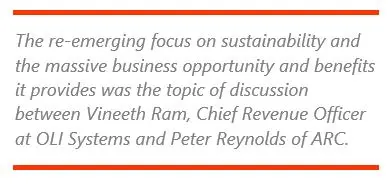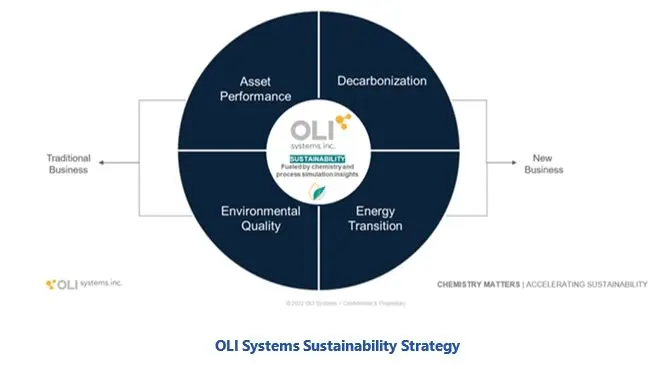

Keywords: Sustainability, OLI Systems, Decarbonization, Energy Transition, Geothermal Energy, Hydrogen Economy, Water & Wastewater Treatment, Process Simulation, Chemistry Insights, ARC Advisory Group.
Sustainability is not a new concept in industry circles. Earlier, it seemed like an idealistic goal; today, it forms the core of all business operations. It is like old wine in a new bottle. It is said to be a re-emerging business focus as it is not new, but the  motivation and drivers are different. Companies have been talking about carbon capture, alternate clean energy sources and so on for the last three decades, but this level of interest, investment (private and public), and commitment was clearly lacking.
motivation and drivers are different. Companies have been talking about carbon capture, alternate clean energy sources and so on for the last three decades, but this level of interest, investment (private and public), and commitment was clearly lacking.
Sustainability drivers today cover the gamut from environmental regulations, financial incentives, government funding, reporting requirements, and commercial investments. It is a re-emerging business and has a multi-pronged opportunity across research and development, early-stage technology innovation, and mature business reinvention. This was the topic of discussion between Vineeth Ram, Chief Revenue Officer at OLI Systems and Peter Reynolds of ARC.
OLI Systems is a pioneer in electrolyte and water chemistry modeling and its application to complex chemical processes in industrial environments with emphasis on technological innovation. The company delivers comprehensive process modeling solutions for water chemistry based industrial applications that enhance operational efficiency, sustainability and engineering productivity while mitigating operational risk. OLI has prioritized five major areas of focus for sustainability related process modeling innovations:
Critical materials processing
Geothermal energy production
Hydrogen production, transport and storage
Water and wastewater treatment
Carbon capture, transport, storage and utilization
At OLI, sustainability has always been at the heart of its operations. While the traditional focus has been on environmental quality and asset performance, the sustainability strategy has now evolved to a multi-pronged approach that includes decarbonization and energy transition innovations. The following are the focus areas for OLI in sustainability - processing of critical materials (nickel, cobalt, lithium, manganese, rare earth elements, etc.) required to fuel clean energy (EV batteries, magnets for wind energy, etc.), geothermal energy and clean hydrogen production, wastewater treatment, and carbon capture, transport and storage.

OLI built its own special purpose process simulation tool that excels where electrolyte and water chemistry-based reactions and phenomena play a critical role. It has now become highly sophisticated and mission critical for several sustainability related applications and use cases.
The OLI Cloud APIs and Cloud Apps democratize electrolyte-based simulation by delivering chemistry insights anywhere, anytime to any user or application. While the OLI Cloud App platform enables users to create and publish their own Apps, the OLI CO2 Transport Cloud App is a good example of a customized sustainability application to accelerate decarbonization. This App predicts the acceptable level of impurities (nitrogen dioxide, sulfur dioxide, hydrogen sulfide, oxygen, etc.) in CO2 streams to mitigate risk of corrosion during transportation.
The app accurately predicts the behavior of supercritical CO2 with impurities and delivers this information in a simple and easy to use manner to materials engineers, field engineers and operations supervisors. A whole host of new use cases and applications that were not previously available or envisaged can now be delivered as Cloud Apps across all areas of sustainability and in the following areas:
When it comes to critical materials the focus is on improving extraction and purification processes to enhance yields and purity levels that result in higher operations efficiency while mitigating the environmental impact of these processes. Over the last decade, OLI has participated in top-tier R&D programs and engaged with early adopter clients to hone its technology to accurately model the processing of rare earth elements, lithium, nickel, cobalt, and manganese. OLI has unique capabilities for lithium-ion battery (LiB) and electronic waste recycling that are being used by the largest global recyclers and emerging technology startup companies.
OLI has been a dedicated partner to the USDOE’s Critical Materials Institute (CMI) for over a decade to conduct innovative research in the extraction, purification, and refining of critical materials as well as battery and e-waste recycling. Future opportunities include expansion of chemistries for new applications, modeling capabilities for novel extraction, and refining processes and phenomena. This includes deeper engagement with other DOE/NSF/ARPA-e funded projects and research ecosystems to recover critical materials from traditional sources as well as produced water, coal ash, acid mine draining, and geothermal brines.
Geothermal energy is rapidly gaining popularity across the world. While the US is the leading producer of geothermal energy, other regions of the world are growing at a significantly faster pace. Heat pumps from geothermal energy are widespread in Europe and signify a transition that is very strategic from an energy security perspective. Next generation geothermal energy technology breakthroughs can go many miles into the earth’s crust, which has the potential to supply all the world's energy needs in a clean and sustainable manner. Its widespread adoption also requires it to become cost effective with other traditional and clean energy sources.
The opportunity for process modeling innovation is immense when it comes to the accurate prediction of mineral scaling and corrosion in geothermal production. The efficient extraction of critical materials from geothermal brines is another significant opportunity. OLI is leading a USDOE SBIR project on Geothermal Asset Integrity to expand its model predictions to geothermal environments in partnership with DNV and Dr. Narasi Sridhar, a renowned corrosion expert. OLI is actively exploring the opportunity to engage in research collaborations with the newly announced USDOE Geothermal Consortium, GEODE, to accelerate R&D innovation to more aggressive geothermal conditions.
Clean hydrogen production, transport and storage is another area where OLI can deliver unique capabilities to optimize process design and operations. The supply of ultra-pure water for electrolysis and the electrolysis process are areas OLI technology can provide valuable insights. When it comes to hydrogen transport and storage, OLI can deliver valuable chemistry insights on the behavior of impurities and sub-surface reactions to enhance efficiency and effectiveness. Many of these processes are driven by fundamental electrolyte and water chemistry behavior and associated phenomena, which is where OLI has deep strengths to successfully address complex challenges.
The opportunities lie in the production of high purity water and enhancement of the reliability of electrolyzers in clean hydrogen production. Mitigating the risk of corrosion and enhanced reliability of sub-surface storage particularly in salt caverns is another opportunity. Understanding the role of impurities during the transportation of hydrogen could also be an opportunity for OLI.
With water and wastewater treatment, in addition to optimizing the process design, improving water quality by eliminating toxic contaminants and lowering energy costs become extremely important; they can be examined in a granular manner with the OLI technology. The cost of chemical treatment programs can be significantly reduced by mitigating mineral scaling and fouling using rigorous chemistry insights.
OLI has developed a partnership with the USDOE ‘s National Alliance for Water Innovation (NAWI). This is a multi-faceted engagement that spans fundamental model development, R&D as well as technology consulting for bench/lab scale pilots as well as demonstration projects. Future innovation opportunities for OLI include additional water and wastewater treatment applications within the NAWI ecosystem and the extraction of pollutants like PFAs.
Driving innovation across the entire CO2 chain of capture, transport, storage, and utilization impacts process design, asset performance, operating efficiency, and reliability. Corrosion mitigation is a key challenge in CO2 Transport and Storage. OLI is a partner in a multi-decade Joint Industry Program (JIP) led by the Institute for Energy Technology (IFE) in Norway on CO2 Transport with members who represent large energy producers and their suppliers. This research has enabled OLI to continually enhance its state-of-the-art models to lead the industry in the future. OLI is driving sustainability innovation in another multi-year USDOE funded CO2 Capture project led by SRI International to commercialize a novel, sustainable capture process.
OLI technology has enabled the successful development of innovative and sustainable CO2 capture processes that are on a firm path to commercialization. OLI has developed state-of-the-art, industry leading simulation technology for mitigating corrosion risk during CO2 transportation. This tool predicts the “safe” level of impurities that can be present in CO2 streams and can be used by CO2 emitters and transporters to improve operations efficiency and reliability. OLI technology has been used by start-up companies to design processes that convert captured CO2 into novel building materials. CO2 storage in sub-surface locations can leverage chemistry behavior from the OLI technology to enhance reliability and safety.
The growth forecast for all these focus areas in the coming decades (decarbonization, energy transition, and environmental quality) as well as government and private investments in R&D are substantial. The OLI technology can deliver value from ideation to large-scale demonstrations in both government funded and commercial programs. Vineeth shared OLI’s sustainability framework to engage government and emerging ecosystems. He also discussed sustainability priorities by technology readiness levels and how the OLI technology can be used to unlock value across all stages of technology development in these focus areas.
OLI understands the chemical phenomena to build highly specialized thermophysical modeling (TPM). Over the last five decades, OLI has developed a comprehensive chemistry property database and thermodynamic, kinetic models to predict chemistry behavior, mineral scaling, corrosion and chemical process behavior. These capabilities can be accessed through a software platform that can be used to create optimal designs or monitor and automate real-time operations through either a traditional desktop license or, the Cloud.
Sustainability has emerged as the linchpin across industries and is defined as “meeting the needs of the present without compromising the ability of future generations to meet theirs.” OLI with its continuum of innovative technologies and proven solutions is accelerating industrial growth in a sustainable manner. The company’s approach and tools help tackle myriad complex chemistry challenges across a broad range of industrial environments to address every aspect of sustainability; optimal asset performance maximizes resource utilization and lowers the carbon footprint. Technologies to accelerate decarbonization and energy transition enhance critical capabilities required to meet the net zero goals. Air, water quality and hazardous materials focused simulation solutions help to enhance environmental quality. Going ahead, OLI plans to develop more collaborative partnerships and technology capabilities to make a greater impact on global sustainability.
ARC Advisory Group clients can view the complete report at the ARC Client Portal.
Please Contact Us if you would like to speak with the author.
Here, you can learn more about the Process Simulation and Optimization Market.

